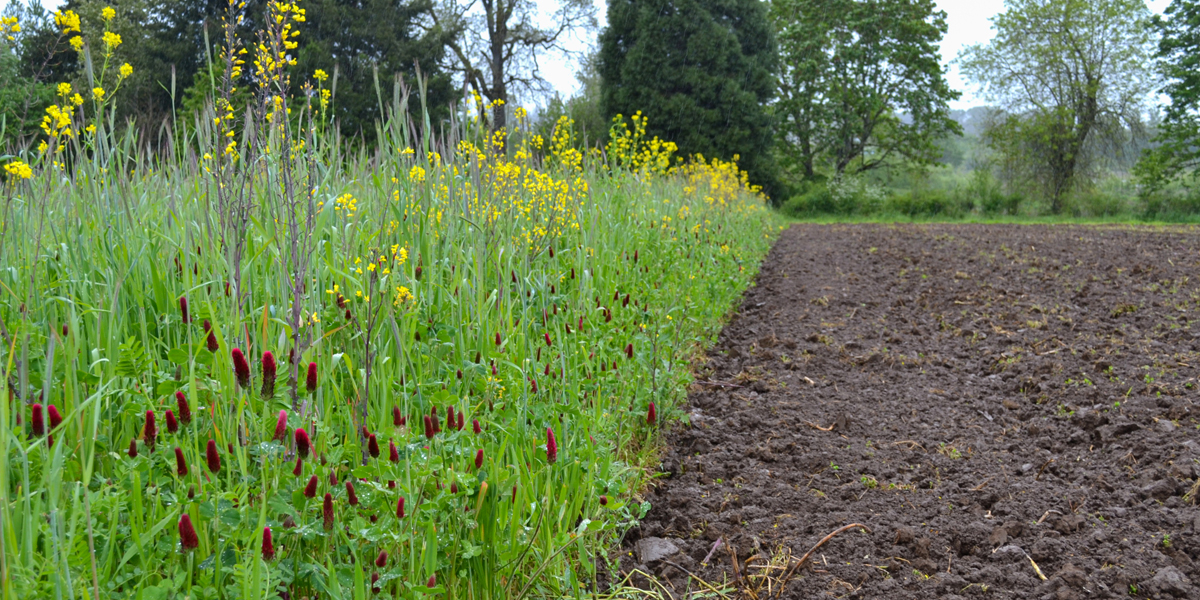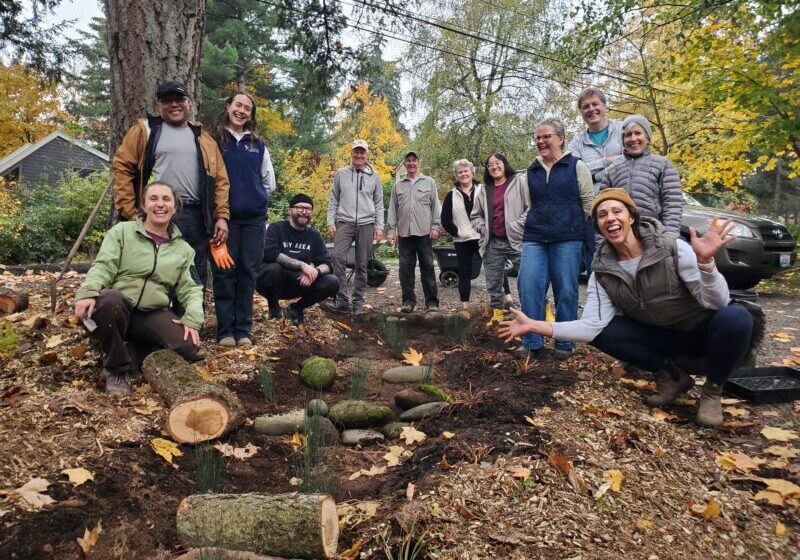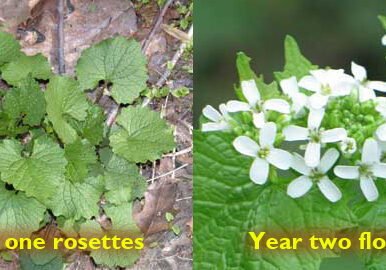Reciprocity is the exchange of things for the mutual benefit of those involved. When talking about a relationship with soil on a conventional working farm or forest, there is often a one way exchange – growing food or fiber then just walking away. Chemical additives can make up for the nutrients that are taken from the soil in order to produce our goods, but this is a temporary fix with potential for long-term consequences and further dependence on human intervention. It breaks the natural cycle, creates a different potentially harmful cycle, and is not an act of giving to the soil. Chemical additives only feed the growing plant, not the soil ecosystem.
Long-term reliance on chemical additives is a symptom of lost organic matter. Growing plants absorb nutrients from the soil which, in healthy soil ecosystems, come from decayed organic matter left behind from plants that had grown and died there previously. During harvest, that decayed organic matter is removed in the form of the new crops. In addition, by relying on chemical fertilizer, conventional growers not only miss out on some of the fertility offered by the organic matter, their soil also loses some of its ability to hold onto nutrients. Nutrients are only held in clays and organic matter, not sand or slit, so reduced soil organic matter means lower cation exchange capacity which is the measure of the ability of a soil to hold onto nutrients and have them available to the crops.
An increased reliance on chemicals has an economic impact as well. The cost of both the chemicals themselves and the gas to drive the tractor to apply them are always going up. Also, when the soil loses its ability to hold onto nutrients it means there is more potential for those nutrients to get into groundwater and streams.
And there’s further potential for problems! Less organic matter also means less ability for the soil to hold onto moisture which therefore increases the need for irrigation, both in frequency and volume of water. This can also lead to increased need for other pesticides, as pest pressure is typically higher when the soil doesn’t have a solid soil ecosystem that supports the predators and other natural controls to those pests.
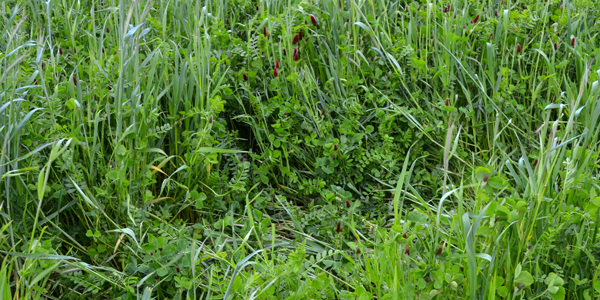
One relatively easy alternative to this complex and unsustainable growing method, and a great way to give back to the soil, is to plant cover crops. In a basic sense, a cover crop is one that is grown not for direct benefit, like cash or food, but for providing a living thing that can nurture soil biology and structure. When we give back to the soil we are providing resources not just for the crop, but also for the biology of that soil and what it needs to thrive. In other words, when we truly give back to the soil, we are helping to create a healthy soil.
Growing cover crops does not need to be complicated. Here in Oregon, we are lucky to have early fall rains before plants go dormant for the winter. Around September 15th to October 15th is a great time of year to seed a cover crop. There will be enough rain to sprout and support the cover crop before winter allowing it to provide protection and nutrients to the soil. Climate experts are not expecting the rainy season to shift significantly in the near future, meaning there will reliably be rain during that September to October period, however they are predicting – and we are already seeing – that intensity of winter rain storms will continue to increase. Having a cover crop established protects soil from erosion during those more intense storms.
Come spring time, about a month before planting your “cash” crop, terminate the cover crop. This can involve mowing, crimping, or clipping the cover crop. It can be left as a green mulch to suppress weeds or be incorporated into the soil for faster breakdown. On a farm that might involve tilling or spading in the cover crop. In a garden, simply throw some compost or “garden soil” on top. Avoiding tilling will help retain the soil structure you created over the winter and your crops will thank you because it will be easier for their roots to grow and for water to soak in.
Plus there is no need to overthink selecting a type of cover crop. Most farm and garden stores sell a mixture – usually about 1/3 clover or other nitrogen fixer (plants that can pull nitrogen out of the air and bring it down in the soil) and 2/3 other plant species that will create organic matter. For instance, an oat, ryegrass, and clover mixture is great for first time cover croppers. Just keep note on what does well, and what does not and adjust the following fall.
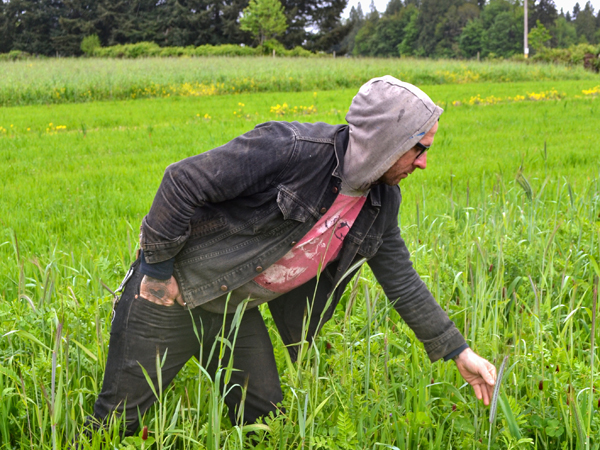
If done right, cover crops can provide just about everything the cash crops and the soil need. Routinely growing cover crop stands that reach four feet tall, Brian Wood, co-owner and co-manager of Sauvie Island Growers, is able to get to enough nitrogen for most of their crops just through cover cropping. Covering 30 acres including 9 acres for vegetable production, Sauvie Island Growers sits in the middle of Sauvie Island and produces salad mixes, potatoes, squash, and other greens to local restaurants and grocery chains.
For Brian, cover cropping comes down to economics. The farm is typically able to produce enough plant available nitrogen to support 75-100% of the crop needs per year – depending on the crop. This means literally spending pennies to the dollar on what synthetic and organic fertilizers cost. For many crops, his only off-farm additions are micronutrients like boron and manganese as well as adjustments for pH.
Brian also includes fallow fields in his rotations –fields that are not producing cash crops – and keeps them in a year-round cover crop. Those fields are typically the most productive of all their farm fields in the year they are returned to producing cash crops. These fields also provide cover and feed for wildlife, and by letting his cover crops flower, Brian also helps the pollinators that will eventually pollinate his crops as well.
Just like any good relationship, giving back to the soil leads to a stronger union. Farms and gardens with healthy and “happy” soils tend to be more productive and require fewer inputs, or amendments. Cover cropping is an easy way to give a gift to something which provides so much.
For questions on cover cropping, soil health, and reciprocity with your soil – please contact Scott Gall, Rural Conservationist (scott@wmswcd.org).
